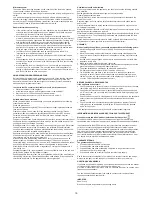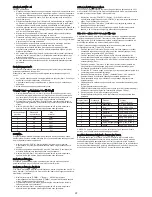
16
17
Microwave power
The choice of power setting depends on the condition of the food to be cooked.
In most cases, the food is cooked on full power.
Full power is used, among other things, for reheating food quickly, boiling water or
similar.
Low power is principally used to defrost food and prepare dishes containing
cheese, milk or egg. (Whole eggs in their shell cannot be cooked in the appliance,
as there is a risk of the eggs exploding.) In addition, lower power settings are also
used to finish off and to retain the excellent aroma of a dish.
General information on cooking
• If the whole meal is to be prepared in the appliance, it is recommended that you
start with the most compact foods, such as potatoes. Once these are ready,
cover them while the rest of the food is prepared.
• Most food should be covered. A close-fitting cover retains the steam and
moisture, which shortens the cooking time in the appliance. This is particularly
the case when cooking vegetables, fish dishes and casseroles. Covering food
also distributes the heat better, thus ensuring rapid and excellent results.
• In order to achieve the best possible results, it is important to position the
food correctly, as the microwave rays are most powerful in the centre of the
appliance. If, for example, you are baking potatoes, you should position them
along the edge of the glass turntable so that they cook evenly.
• In order to cook compact dishes such as meat and poultry evenly, it is
important to turn the pieces of meat a few times.
• You can use the appliance for baking, although not with recipes that include
yeast.
• When preparing food with a thick skin, e.g. potatoes, apples, whole squash or
chestnuts, you should prick holes in the skin to prevent the food from bursting
during cooking.
• When preparing food in a “traditional” oven, you normally avoid opening the
oven door as much as possible. This is not the case with this appliance: no
energy or significant heat is lost. In other words, you can open the oven door
and look at the food as often as you want.
USING UTENSILS WHEN PREPARING FOOD
Before starting to prepare food in containers, you should check that the containers
you wish to use are made of a suitable material, as some types of plastic may
become limp and deform, while some types of ceramics may crack (particularly
when heating small quantities of food).
In order to test if a container is suitable for use in a microwave oven:
• Place the container in the appliance.
• At the same time, place a half-full glass of water in the container.
• Start, and run for 15-30 seconds on maximum power.
• If the container becomes very hot to the touch, avoid using it.
Suitable utensils and materials
When you prepare food in the appliance, you should preferably use the following
utensils and materials:
Glass and glass bowls
Stoneware (glazed and unglazed). The food stays hot longer in glazed stoneware
than in other dishes.
Plastic containers. Can be used for many heating purposes. Caution! Plastic
containers made from melamine, polyethylene and phenol must NOT be used.
Porcelain. All porcelain can be used in microwave ovens, although fireproof
porcelain is preferable.
Fireproof covered dishes. Glass dishes with lids that fit so closely that steam cannot
escape are ideal for vegetables and fruit to which no liquid is added (however, the
cooking time must not exceed 5 minutes).
Browning dishes. You must be very careful when using this type of dish. Never heat
the browning dish for more than 5 minutes on the turntable. Suitable insulation,
such as a heat-tested plate, should be placed between the browning dish and the
turntable to prevent the turntable from overheating.
Appliance roasting film can be used, particularly for soups, sauces, stewed dishes
or when defrosting food. Can also be used as a loose covering to prevent fat, etc.
from spraying out into the oven compartment.
Kitchen roll is ideal, as it absorbs moisture and fat. For example, bacon can be
placed in layers, with kitchen roll between each layer. The bacon will then be
completely crispy, as it does not sit in its own fat. Home-baked bread can be taken
directly from the freezer, packed in kitchen roll and heated in the appliance.
Wet kitchen roll can be used for fish or vegetables. Covering the food prevents it
from drying out.
Greaseproof paper Fish, large vegetables, such as cauliflower, corn on the cob and
similar can be packed in wet greaseproof paper.
Roasting bags are ideal for meat, fish and vegetables. However, they must never be
closed using metal clips. Cotton thread should be used instead. Prick the bag with
small holes, and place it in the appliance on a plate or glass dish.
Unsuitable utensils and materials
When you prepare food in the appliance, you should not use the following utensils
and materials:
Sealed glass/bottles with small openings, as they may explode.
General purpose thermometers
Silver foil/foil trays, as the microwave rays cannot penetrate the material and the
food will not cook.
Recycled paper, as it may contain small metal splinters that could cause sparks
and/or a fire.
Closed tins/containers with tightly sealed lids, as excess pressure may cause the
tin/container to explode.
Metal clips and other lids/foils, containing metal wires. These can form sparks in the
appliance and must therefore be removed.
Metal bowls/containers and packaging, unless they are designed specifically for use
in microwave ovens. The microwaves are reflected and cannot penetrate the food
through the metal.
Plates, dishes and bowls/containers with metal, gold and silver decorations. They
may break and/or cause sparks to form in the oven compartment.
CLEANING
When cleaning the appliance, you should pay attention to the following points:
• Switch the appliance off and remove the plug from the wall socket before
cleaning.
• Never use scouring powder, steel scourers or other strong cleaning agents to
clean the interior or exterior surfaces of the appliance, as they may scratch the
surfaces.
• Instead use a cloth dampened with hot water, and add washing-up liquid if the
appliance is very dirty.
• Make sure that no water gets into the vent holes.
• The spindle and the floor of the appliance must be cleaned regularly so that the
glass turntable can move around without hindrance.
• The glass turntable and spindle can be cleaned in a dishwasher.
• Do not remove the mica plate (2) from the inside of the oven!
• Tip: When the oven has been in use for some time, the oven compartment
can begin to smell. If the smell is not dispersed by ordinary cleaning, place a
few lemon slices in a cup and cook them in the appliance at full power for 2-3
minutes. This will effectively disperse the smell.
BEFORE GOING TO A REPAIR CENTRE
If the appliance will not start:
• Check that the plug is correctly in place in the wall socket. If that is not the case,
remove the plug, wait 10 seconds and then plug it in again.
• Check whether a fuse has blown or whether the fuse relay has been switched
off. If it is not that, you can check that the socket itself is working by plugging in
another device.
• Check that the oven door is closed properly. If this is not the case, the automatic
safety system via the lock dowels (9) ensures that the appliance cannot be
started.
• Check the child lock is activated (lock symbol appears on display). The child
safety lock can be deactivated by holding the "Stop/cancel" button pressed
down for 3 seconds.
If the appliance still does not work, you should contact a repair engineer.
INFORMATION ON DISPOSAL AND RECYCLING OF THIS PRODUCT
Please note that this Adexi product is marked with this symbol:
This means that this product must not be disposed of together with ordinary
household waste, as electrical and electronic waste must be disposed of separately.
In accordance with the WEEE directive, every member state must ensure correct
collection, recovery, handling and recycling of electrical and electronic waste.
Private households in the EU can take used equipment to special recycling stations
free of charge. In certain member states, used appliance can be returned to the
dealer where they were bought on the condition you buy new products. Contact
your retailer, distributor or the municipal authorities for further information on what
you should do with electrical and electronic waste.
GUARANTEE TERMS
The guarantee does not apply:
• if the above instructions are not followed
• if the appliance has been interfered with
• if the appliance has been mishandled, subjected to rough treatment, or has
suffered any other form of damage
• if faults have arisen as a result of faults in your electricity supply.
Due to the constant development of our products in terms of function and design,
we reserve the right to make changes to the product without prior warning.
QUESTIONS AND ANSWERS
If you have any questions regarding use of the appliance and cannot find the answer
in this user guide, please try our website at www.adexi.eu.
Go to the "Consumer Service" menu, click on "Question & Answer" to see the most
frequently asked questions.
You can also see contact details if you need to contact us for technical issues,
repairs, accessories and spare parts.
IMPORTER
Adexi Group
We cannot be held responsible for any printing errors.









































